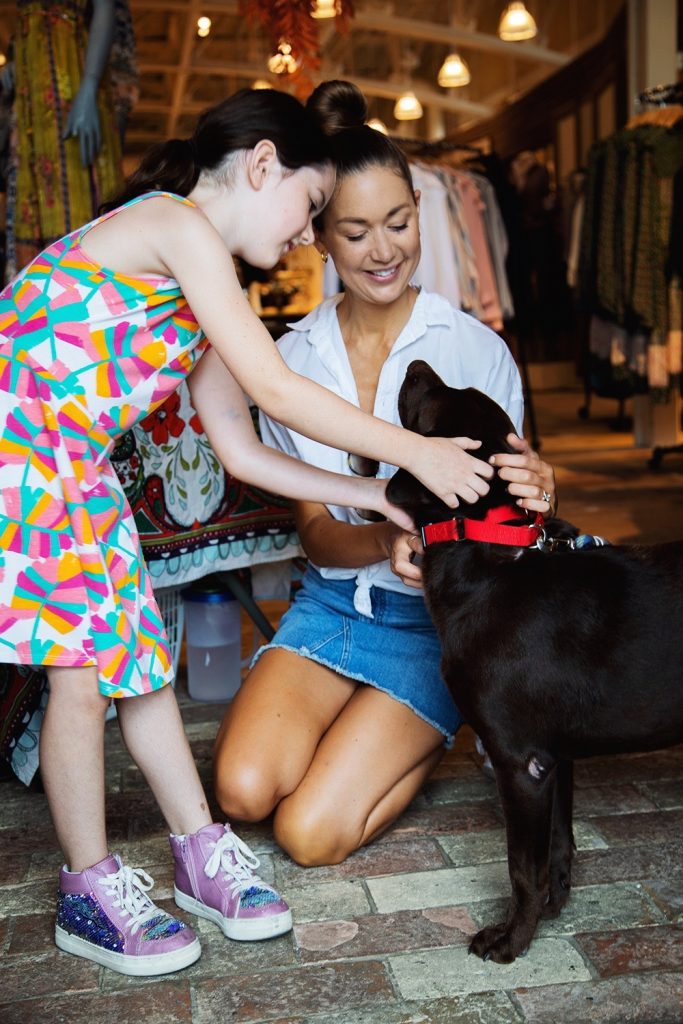Phoebe has reached that age where she asks at least once a week when we’re getting a dog. And considering that I grew up with the most faithful golden retriever ever to walk the planet (RIP Duchess), there’s a part of me that’s tempted to rush out and adopt one right away. But, I know in my heart that this current season of our lives when we’re rarely home during weekdays (and frequently traveling on weekends), the timing isn’t right for us to create the home environment that a dog would need just yet.
That said, my kids’ passion for animals has reignited my own desire to get involved and find ways to help the millions of dogs, cats, bunnies (and more sweet pets) in need of homes all over the U.S… and as I’ve started doing the research, I’ve learned there are all kinds of outside-the-box ways to make a difference, and that let my kids bond with animals in the process.
For this post, we’re teaming up with our friends at Frost Bank in their Opt for Optimism program. The initiative is about showing through our actions that, with time and money, we can all afford to make a difference in our communities and in the lives of others.
I’m especially excited to be participating in this campaign, because I’m such a believer in the power of optimism. Though many people associate the word with naïve happiness or blind positive thinking, the true meaning of optimism is about the belief that a positive solution is possible with the right approach. It’s expecting good things to happen, even when we experience adversity along the way. And the research shows that when those bumps in the road do happen, optimists handle them better and recover more quickly. It’s a mindset shift that any of us can choose, at any time.
Here are some great ways you can change an animal’s life today:
Adopt a pet.
The first step is to consider your lifestyle and home setup, and how much time you have to devote to your pet every day. In general, cats are typically a little lower maintenance than dogs, and don’t need to be walked or let outside to use the bathroom if you’re at work all day. That said, every animal is going to need fresh water, food, cleaning, and love every day, so make sure you can provide a supportive and loving home for your pet.
There are so many connections between animals and our overall sense of well-being. Frost’s research (read about the study here) shows that taking steps towards joy and optimism can positively impact our lives in incredible ways. Beyond finances, optimism can be a catalyst for better physical and emotional health and can encourage us to turn challenges into opportunities. It can change perspectives and the way we view and interact with the world.
Avoid the pet store and instead visit a local shelter to find cats, dogs, birds, gerbils, and more who are waiting to be adopted by their new families. A few compelling facts from the Shelter Pet Project:
- 6–8 million animals end up in shelters each year, half of which will probably not be adopted.
- 25 percent of pets in shelters are purebreds. Breed-specific rescue groups always have purebred dogs and puppies looking for new homes.
- Most pets end up homeless through no fault of their own—”moving” and “landlord issues” are the top reasons people give for relinquishing their pets, meaning shelters and rescue groups are full of wonderful, family-ready pets.
- Pets adopted from shelters and rescue groups typically cost less than pets purchased or even acquired for free—once you add in the cost of vaccinations, spay/neuter surgery, microchip, dewormer and other “extras” included in your adoption fee, you’ll probably be surprised what a bargain an adopted pet really is!
If you aren’t quite ready for a long-term relationship, consider fostering! It’s a great way to experience the joy of pet ownership and help an animal that needs it most, even if you’re not ready for a years-long commitment.
Volunteer at an animal shelter.
In addition to petting and walking the animals, most local shelters usually need volunteers for office work, adoption events, cleaning dishes and food bowls, special events (such as adoption programs), fostering animals, and much more. This is one of the most fun ways to volunteer with kids and teaches empathy and kindness, as they see firsthand the power of showing someone love who really needs it. According to Frost’s survey, most Americans want more optimism in their lives, and by taking steps towards generosity of both time and money, we can actually bring more positivity and joy into our lives and the lives of others.
Many shelters require kids to be a little older before they can officially volunteer, but mine love to visit our neighborhood shelter and just pet the animals. Here are the basics on how to volunteer:
- Find your local animal shelter or humane society. Find out about whether it’s a no-kill shelter and other details that may be important to you. A few in Central Texas that I love are PAWS Shelter, Safe in Austin, and Austin Pets Alive.
- Check the website for volunteer opportunities or the contact info of the volunteer coordinator.
- Consider whether you can make it work with your schedule. Most volunteer opportunities occur during a shelter’s opening hours, although there are some opportunities to care for animals and do maintenance work during the off-hours.
- Attend a training session and find the role that works for you. I’ve found that with any volunteer opportunity, it’s likely not going to be glamorous and may not always be fun, but the work should tap into your abilities and passions so that you’re motivated to stick with it.
Also, I have to tell you guys about a volunteer opportunity I’ve got on the books for next month: I’m going to be a guest judge at the annual Barkitecture event, where 21 Austin-based architects build dog houses to benefit 3 charities (Safe in Austin, Lone Star Doberman Rescue and Austin Pets Alive.) It’s Sunday, October 27th at Fair Market. If you’re in Austin, come on by from noon – 4pm.
Donate to the cause.
Every charity needs donations of time and money to continue doing the work that they do — they rely on the generosity of donors who care about the cause in order to keep their doors open. If you can’t afford to spend much time volunteering at a shelter, you can help out by donating money and animal-care items. Ask your local shelter for a list of items they need (many of them will accept used items!) Think toys, blankets and towels, food and treats, grooming items, and more.
***
Volunteering with our kids (or our friends, or other family members!) is so important, and I truly believe that we get back even more than we give in terms of joy and fulfillment in life. I’d love to hear how you guys are volunteering and spreading a spirit of generosity in your own communities. Have you encountered any roadblocks in your efforts? What have been some of the charities where you’ve had good volunteering experiences?
This post is in partnership with Frost Bank and their Opt for Optimism program. Read more from the latest research about the fascinating link between optimism and financial health and check out volunteer opportunities in your city here.










